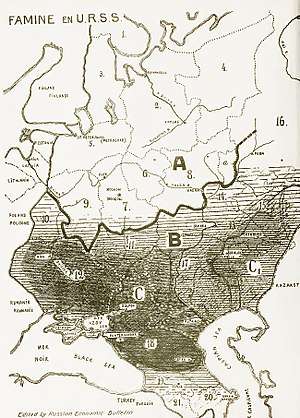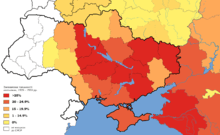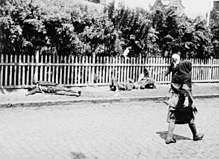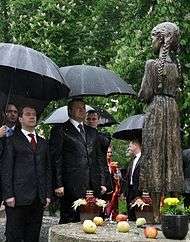Soviet famine of 1932–33


The Soviet famine of 1932–33 was a major famine that killed millions of people in the major grain-producing areas of the Soviet Union, including Ukraine, Northern Caucasus, Volga Region and Kazakhstan,[2] the South Urals, and West Siberia.[3][4] The Holodomor in Ukraine and Kazakh famine of 1932–33 have been seen as genocide committed by Joseph Stalin's government ; it is estimated between 3.3[5] and 7.5[6] million died in Ukraine and ~2,000,000 (40% of all Kazakhs) died in Kazakhstan.[7][8][9]
Early estimates of the death toll by scholars and government officials varied greatly; anywhere from 4.5[10] to 7 million[11] ethnic Ukrainians were said to have perished as a result of the famine. Recent research has since narrowed the estimates to between 2.4[12] and 4[6] million. The exact number of deaths is hard to determine, due to a lack of records,[13][14] but the number increases significantly when the deaths in heavily Ukrainian-populated Kuban are included.[15] Older estimates are still often cited in political commentary.[16] According to the findings of the Court of Appeal of Kiev in 2010, the demographic losses due to the famine amounted to 10 million, with 3.9 million direct famine deaths, and a further 6.1 million birth deficit.[13]
Stalin and other party members had ordered that kulaks were "to be liquidated as a class" and so became a target of the state. The richer, land-owning peasants were labeled 'kulaks" and were portrayed by the Bolsheviks as class enemies, which culminated Soviet campaign of political repressions, including arrests, deportations, and executions of large numbers of the better-off peasants and their families in 1929–1932.
The forced collectivization of agriculture as a part of the Soviet first five-year plan, forced grain procurement, combined with rapid industrialisation, a decreasing agricultural workforce, and several bad droughts, were the main reasons for the famine. The famine is sometimes seen by historians as a deliberate act of genocide against ethnic Ukrainians and Kazakhs, though some disagree, citing the fact that land-owning peasants (Kulaks) were in favor of private property, which is diametrically opposed to the Communist Party's fundamental tenets.[17]:507 Gareth Jones was the first Western journalist to report the devastation.[18][19][lower-alpha 1] In addition to the Kazakh famine of 1919–1922, in 10–15 years Kazakhstan lost more than half of its population due to the actions of the Soviet power. The famine made Kazakhs a minority in their own republic, and not until the 1990s did Kazakhs become the largest group in Kazakhstan again. Before the famine, around 60% of the republic's population were Kazakhs, but after the famine, only around 38% of the population were Kazakhs.[20][21]
Reasons
Unlike the previous famine of 1921–22, Russia's intermittent drought was not severe in the affected areas at this time.[22]
Historian Mark B. Tauger of West Virginia University suggests that the famine was caused by a combination of factors, specifically low harvest due to natural disasters combined with increased demand for food caused by the collectivization, industrialization and urbanization, and grain exports by the Soviet Union at the same time.[23]
A similar view was presented by Stephen Wheatcroft, who has given more weight to the "ill-conceived policies" of Soviet government and highlighted that while the policy was not targeted at Ukraine specifically, it was Ukraine who suffered most for "demographic reasons".[24]
Lewis H. Siegelbaum, Professor of History at Michigan State University, states the Ukraine was hit particularly hard by grain quotas which were set at levels which most farms could not produce. The 1933 harvest was poor, coupled with the extremely high quota level, which led to starvation conditions. The shortages were blamed on kulak sabotage, and authorities distributed what supplies which were available only in the urban areas. The loss of life in the Ukrainian countryside is estimated at approximately 5 million people.[25]
The Law of Spikelets
The "Decree About the Protection of Socialist Property" – nicknamed by the farmers the Law of Spikelets – was enacted on August 7, 1932. The purpose of the law was to protect the property of the collective farms. It was nicknamed the Law of Spikelets because it allowed people to be prosecuted for gleaning leftover grain from the fields. There were more than 200,000 people sentenced under this law.[26]
Passports

There was a wave of migration due to starvation, and authorities responded by introducing a requirement that passports be used to go between republics, and banning travel by rail.
Soviet internal passports (identity cards) were introduced on 27 December 1932 to deal with the mass exodus of peasants from the countryside. Individuals not having such a document could not leave their homes on pain of administrative penalties, such as internment in Gulag labor camps. The rural population had no right to freely keep passports and thus could not leave their villages without approval. The power to issue passports rested with the head of the kolkhoz, and identity documents were kept by the administration of the collective farms. This measure stayed in place until 1974.
The lack of passports could not completely stop peasants' leaving the countryside, but only a small percentage of those who illegally infiltrated into cities could improve their lot. Unable to find work or possibly buy or beg a little bread, farmers died in the streets of Kharkiv, Kiev, Dnipropetrovsk, Poltava, Vinnytsia, and other major cities of Ukraine.
Reactions


The famine of 1932–1933 was officially denied, so any discourse on this issue was classified as criminal "anti-Soviet propaganda" until Perestroika. The results of the 1937 census were kept secret as they revealed the demographic losses attributable to the Great Famine.
Some well-known journalists, most notably Walter Duranty of The New York Times, downplayed the famine and its death toll.[27] In 1932, he received the Pulitzer Prize for Correspondence for his coverage of the Soviet Union's first five-year plan and thus, he was considered the most expert Western journalist to cover the famine.[27] In an article "Russians Hungry, But Not Starving", he responded to an account of starvation in Ukraine and, while acknowledging that there was widespread malnutrition in certain areas of the USSR (including parts of the North Caucasus and Lower Volga), generally downplayed the scale of the starvation and claimed that there was no famine.[28] Duranty's coverage led directly to Franklin Roosevelt officially recognizing the Soviet Union in 1933 and thus revoked the United States' official recognition of an independent Ukraine.[29] A similar position was taken by the French Prime Minister Edouard Herriot, who toured the territory of Ukraine during his stay in the Soviet Union. However, other Western journalists did report on the famine at the time, including Malcolm Muggeridge and Gareth Jones, who both severely criticised Duranty's account and were later banned from returning to the Soviet Union.[30]
As a child, Mikhail Gorbachev experienced the Soviet famine in Stavropol, Russia. He recalled in a memoir that "In that terrible year [in 1933] nearly half the population of my native village, Privolnoye, starved to death, including two sisters and one brother of my father."[31]
George Orwell's Animal Farm was inspired by Gareth Jones articles about the Great Famine of 1932–1933.[32]
Estimation of the loss of life
- The 2004 book The Years of Hunger: Soviet Agriculture, 1931–33 by R.W. Davies and S.G. Wheatcroft, gives an estimate of 7.5 million deaths.[33]
- Encyclopædia Britannica estimates that 11 to 14 million people died from hunger in the Soviet Union during this period, of whom 4 to 7 million were Ukrainians.[34]
- Robert Conquest estimated at least 11 million peasants' deaths from hunger in the European part of the Soviet Union in 1932–33 (7 million in Ukraine, 2 million in the North Caucasus, and 2 million elsewhere), and an additional 1 million deaths from hunger as a result of collectivization in Kazakh ASSR.[35]
- Another study, by Michael Ellman using data given by Davies and Wheatcroft, estimates "‘about eight and a half million’ victims of famine and repression", combined, in the period 1930–33.[36]
- In his 2010 book Stalin's Genocides, Norman Naimark estimates that 3 to 5 million Ukrainians died in the famine.[37]
- In 2008 Russian state Duma issued a statement about the famine, stating that within territories of Povolzhe, Central Black Earth Region, Northern Caucasus, Ural, Crimea, Western Siberia, Kazakhstan, Ukraine and Belarus the estimated death toll is about 7 million people.[38]
See also
- The Holodomor, the Ukrainian portion of the 1932–33 famine
- Russian famine of 1921
- Kazakh famine of 1932–33, Kazakhstan's portion of the 1932–33 famine
- Droughts and famines in Russia and the Soviet Union
Notes
References
- ↑ Markoff, Dr. Alexandr Pavlovich (1933). professors of the Russian Commercial Institute, eds. "Famine in the USSR" (pdf). Bulletin Economique Russe (in French). 9. Retrieved April 18, 2016.
- ↑ Engerman, David (June 2009). Modernization from the Other Shore (Google Books). ISBN 9780674036529.
- ↑ "Famine on the South Siberia". Human Science. RU. 2 (98): 15.
- ↑ "Demographic aftermath of the famine in Kazakhstan". Weekly. RU. Jan 1, 2003.
- 1 2 David R. Marples. Heroes and Villains: Creating National History in Contemporary Ukraine. p.50
- ↑ NICCOLÒ PIANCIOLA (2001). "The Collectivization Famine in Kazakhstan, 1931–1933". Harvard Ukrainian Studies. 25 (3–4): 237–251. JSTOR 41036834. PMID 20034146.
- ↑ Volkava, Elena (2012-03-26). "The Kazakh Famine of 1930–33 and the Politics of History in the Post-Soviet Space". Wilson Center. Retrieved 2015-07-09.
- ↑ Татимов М. Б. Социальная обусловленность демографических процессов. Алма-Ата,1989. С.124
- ↑ Wheatcroft 2001a.
- ↑ Rosefielde 1983.
- 1 2 Наливайченко назвал количество жертв голодомора в Украине [Nalyvaichenko called the number of victims of Holodomor in Ukraine] (in Russian). LB.ua. 14 January 2010. Retrieved 21 July 2012.
- ↑ "Yulia Tymoshenko: our duty is to protect the memory of the Holodomor victims". Tymoshenko's official website. 27 November 2010. Archived from the original on 2010-11-29. Retrieved 21 July 2012.
- ↑ Naimark 2010, p. 70.
- ↑ "Harper accused of exaggerating Ukrainian genocide death toll". MontrealGazette.com. 30 October 2010. Retrieved 21 July 2012.
- ↑ Marples, David R. (May 2009). "Ethnic Issues in the Famine of 1932–1933 in Ukraine". Europe-Asia Studies. 61 (3): 505–518. doi:10.1080/09668130902753325.
Geoffrey A. Hosking concluded that: Conquest’s research establishes beyond doubt, however, that the famine was deliberately inflicted there [in Ukraine] for ethnic reasons...Craig Whitney, however, disagreed with the theory of genocide
- 1 2 "Welsh journalist who exposed a Soviet tragedy". walesonline.com. November 13, 2009. Retrieved April 7, 2016.
- ↑ Brown, Mark (November 12, 2009). "1930s journalist Gareth Jones to have story retold: Correspondent who exposed Soviet Ukraine's manmade famine to be focus of new documentary". The Guardian. London. Retrieved April 7, 2016.
- ↑ http://world.lib.ru/p/professor_l_k/070102_koval_drujba.shtml - "Запомнил и долю казахов в пределах своей республики - 28%. А за тридцать лет до того они составляли у себя дома уверенное большинство"
- ↑ PIANCIOLA, NICCOLÒ (1 January 2001). "The Collectivization Famine in Kazakhstan, 1931–1933". Harvard Ukrainian Studies. 25 (3/4): 237–251. doi:10.2307/41036834 (inactive 2018-08-28). JSTOR 41036834.
- ↑ Viktor Kondrashin, Голод 1932—1933 годов. Трагедия российской деревни, Moscow, Росспэн, 2008, ISBN 978-5-8243-0987-4., Chapter 6. "Голод 1932—1933 годов в контексте мировых голодных бедствий и голодных лет в истории России — СССР", p. 331.
- ↑ Mark B. Tauger. "Natural Disaster and Human Actions in the Soviet Famine of 1931-1933" (PDF). Archived from the original (PDF) on 2012-08-24. Retrieved 2013-01-27.
- ↑ "The Soviet Famine of 1931-33: Politically Motivated or Ecological Disaster?". www.international.ucla.edu. Retrieved 2015-05-07.
- ↑ Siegelbaum, Lewis H. "Professor, Michigan State University". Seventeen Moments in Soviet History. Michigan State University. Retrieved 26 March 2018.
- ↑ Michael Ellman Archived 2012-12-05 at Archive.is, Stalin and the Soviet Famine of 1932-33 Revisited Europe-Asia Studies, Routledge. Vol. 59, No. 4, June 2007, 663-693. PDF file
- 1 2 Lyons, Eugene (1938). Assignment in Utopia. Transaction Publishers. p. 573. ISBN 978-1-4128-1760-8.
- ↑ Walter Duranty (31 March 1933). "RUSSIANS HUNGRY, BUT NOT STARVING; Deaths From Diseases Due to Malnutrition High, Yet the Soviet Is Entrenched". The New York Times: 13. Archived from the original on 2003-03-30.
- ↑ Taylor, Sally J. (1990). Stalin's Apologist. Oxford University Press.
- ↑ Shipton, Martin (June 20, 2013). "Welsh journalist hailed one of greatest 'eyewitnesses of truth' for exposing '30s Soviet famine". Wales Online.
- ↑ Mikhail Sergeevich Gorbachev (2006). "Manifesto for the Earth: action now for peace, global justice and a sustainable future". CLAIRVIEW BOOKS. p.10. ISBN 1-905570-02-3
- ↑ Obenson, Tambay A. (July 23, 2015). "140 New Projects Selected for the IFP's 2015 Project Forum Slate". indiewire.com. Retrieved April 7, 2016.
- ↑ Davies & Wheatcroft 2004, p. 401.
- ↑ "Ukraine – The famine of 1932–33". Encyclopædia Britannica. Retrieved 2008-06-26.
- ↑ Conquest, Robert (1986), The Harvest of Sorrow: Soviet Collectivization and the Terror-Famine, Oxford University Press, p. 306, ISBN 978-0-19-505180-3 .
- ↑ Ellman, Michael (September 2005). "The Role of Leadership Perceptions and of Intent in the Soviet Famine of 1931–1934" (PDF). Europe-Asia Studies. 57 (6): 823–41. doi:10.1080/09668130500199392. Retrieved 2008-07-04.
- ↑ Naimark, Norman M (2010), Stalin's Genocides (Human Rights and Crimes against Humanity), Princeton University Press, p. 131, ISBN 978-0-691-14784-0 .
- ↑

Sources
- Davies, RW; Wheatcroft, SG (2004), The Years of Hunger: Soviet Agriculture, 1931–33 ; Harrison, Davies, Wheatcroft 2004 (PDF) (review), UK: Warwick .
- Ellman, Michael (June 2007), "Stalin and the Soviet Famine of 1932–33 Revisited" (PDF), Europe-Asia Studies, 59 (4): 663–93, doi:10.1080/09668130701291899 .
- Finn, Peter (April 27, 2008), "Aftermath of a Soviet Famine", The Washington Post .
- Kuromiya, Hiroaki (June 2008), "The Soviet Famine of 1932–1933 Reconsidered", Europe-Asia Studies, 60 (4): 663–75, doi:10.1080/09668130801999912 .
- Kindler, Robert, Stalin's Nomads. Power and Famine in Kazakhstan, Pittsburgh: Pittsburgh University Press, 2018.
- Luciuk, Lubomyr Y, ed, Holodomor: Reflections on the Great Famine in Soviet Ukraine, Kingston, Kashtan Press, 2008
- Markoff, A (1933), Famine in USSR .
- Thorson, Carla (May 5, 2003), The Soviet Famine of 1931–33: Politically Motivated or Ecological Disaster?, UCLA International Institute .
- Wheatcroft, SG (April 1990), "More light on the scale of repression and excess mortality in the Soviet Union in the 1930s" (PDF), Soviet Studies .
- Kondrashin, Viktor, ed. (2009), Famine in the Soviet Union 1929–1934 (PDF) (slide stack), Katz, Nikita B transl. docs.; Dolgova, Alexandra transl. note from compilers; Glizchinskaya, Natalia design, RU: Russian Archives, archived from the original (PDF) on 2009-03-19 .